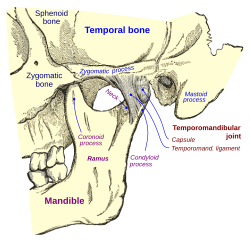| Temporomandibular ligament | |
|---|---|
 Articulation of the mandible. Lateral aspect. | |
| Details | |
| System | skeletal |
| From | zygomatic process of temporal bone |
| To | condyloid process (mandible) |
| Identifiers | |
| Latin | ligamentum laterale articulationis temporomandibularis, ligamentum temporomandibulare |
| TA98 | A03.1.07.003 A03.1.07.004 |
| TA2 | 1624, 1625 |
| FMA | 57071 |
| Anatomical terminology | |
The temporomandibular ligament, also known as the external lateral ligament, is a ligament that connects the lower articular tubercle of the zygomatic arch to the lateral and posterior border of the neck of the mandible. It prevents posterior displacement of the mandible. It also prevents the condyloid process from being driven upward by a blow to the jaw, which would otherwise fracture the base of the skull.
Structure
The temporomandibular ligament originates from the lower articular tubercle of the zygomatic arch.[1] This usually has a rough surface for the ligament to attach to.[1] It attaches to the lateral and posterior border of the neck of the mandible.[1]
It consists of two short, narrow fasciculi, one in front of the other. It is broader above than below, and its fibers are directed obliquely downward and backward.[1]
It is covered by the parotid gland, and by the integument.
Function
The temporomandibular ligament constrains the mandible as it opens, keeping the condyloid process close to the joint.[2] It prevents posterior displacement of the mandible. It also prevents the condyloid process from being driven upward by a blow to the jaw, which would otherwise fracture the base of the skull.
References
![]() This article incorporates text in the public domain from page 297 of the 20th edition of Gray's Anatomy (1918)
This article incorporates text in the public domain from page 297 of the 20th edition of Gray's Anatomy (1918)
Saladin, Kenneth S. (2005) Human Anatomy. New York, NY: McGraw-Hill. ISBN 0-07-039080-0
- ^ a b c d Alomar, X.; Medrano, J.; Cabratosa, J.; Clavero, J. A.; Lorente, M.; Serra, I.; Monill, J. M.; Salvador, A. (2007-06-01). "Anatomy of the Temporomandibular Joint". Seminars in Ultrasound, CT and MRI. Elsevier. 28 (3): 170–183. doi:10.1053/j.sult.2007.02.002. ISSN 0887-2171. PMID 17571700 – via ScienceDirect.
- ^ Osborn, J. W. (1989). "The temporomandibular ligament and the articular eminence as constraints during jaw opening". Journal of Oral Rehabilitation. 16 (4): 323–333. doi:10.1111/j.1365-2842.1989.tb01348.x. ISSN 1365-2842. PMID 2795311.
